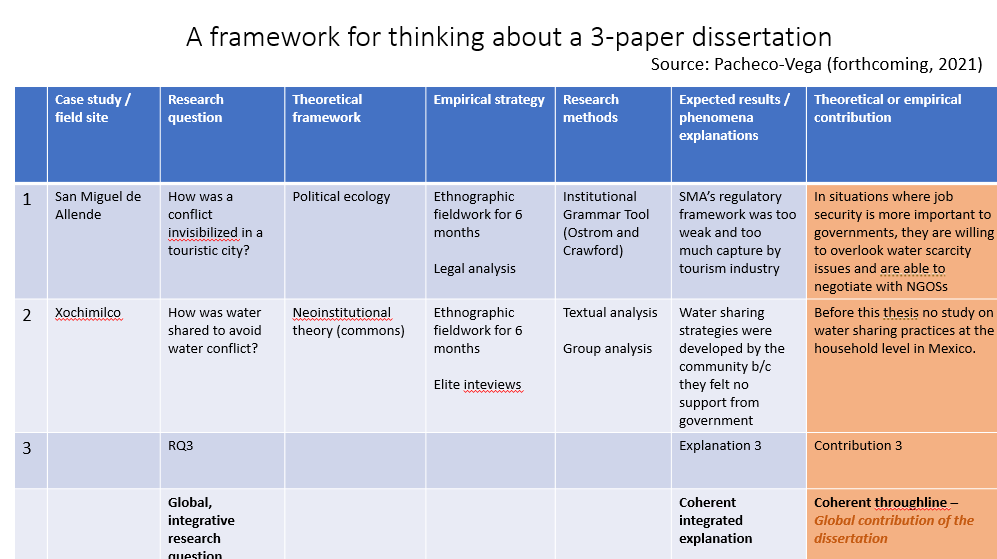
ABRO HILO para Twitter hispanoparlante sobre la redacción de la sección de conclusiones de cada capítulo de la tesis y de la tesis global.
Si leen mi blog regulamente, sabrán que diseñé tres técnicas para ayudar a mis tesistas (de licenciatura, maestría y doctorado).
Si leen mi blog regulamente, sabrán que diseñé tres técnicas para ayudar a mis tesistas (de licenciatura, maestría y doctorado).
Una de mis técnicas más productivas es la Tabla Analítica de la Disertación (Dissertation Analytical Table, DAT)
raulpacheco.org/2019/09/the-di…
Aunque está en inglés, se pueden dar más o menos idea de la estructura de la DAT de una de mis tesistas que se acaba de titular de doctora.
raulpacheco.org/2019/09/the-di…
Aunque está en inglés, se pueden dar más o menos idea de la estructura de la DAT de una de mis tesistas que se acaba de titular de doctora.

Los otros dos dispositivos de control son el Resumen de Tesis de Dos Páginas (Dissertation Two Pager, DTP) raulpacheco.org/2018/08/the-di…
y la Narrativa Global de la Tesis (Global Dissertation Narrative, GDN) raulpacheco.org/2020/01/the-gl…
Todos mis Dispositivos de Control se complementan.
y la Narrativa Global de la Tesis (Global Dissertation Narrative, GDN) raulpacheco.org/2020/01/the-gl…
Todos mis Dispositivos de Control se complementan.
¿Por qué es importante que se enlacen los tres Dispositivos de Control, y cuál es el central? Para mí, los tres son "centrales" en el sentido que es importante que mis tesistas los usen todos.
Sin embargo, todo emana del DTP. Si ustedes tienen un buen DTP, su DAT y GDN...
Sin embargo, todo emana del DTP. Si ustedes tienen un buen DTP, su DAT y GDN...
... fluyen directamente del DTP.
Ahora bien, si observan en la DAT, viene una columna de Resultados Esperados y otra de Contribución Teórica o Empírica. Su sección de Conclusiones en cada capítulo resume sus Resultados + Contribución.
El capítulo de Conclusiones sintetiza...
Ahora bien, si observan en la DAT, viene una columna de Resultados Esperados y otra de Contribución Teórica o Empírica. Su sección de Conclusiones en cada capítulo resume sus Resultados + Contribución.
El capítulo de Conclusiones sintetiza...
... precisamente las Conclusiones de cada capítulo, MÁS establece la Contribución Global de la tesis.
¿Por qué es importante ligar lo que se concluye de cada capítulo con una conclusión global?
Porque el capítulo de Conclusiones sirve tanto para demostrar lo que aprendieron...
¿Por qué es importante ligar lo que se concluye de cada capítulo con una conclusión global?
Porque el capítulo de Conclusiones sirve tanto para demostrar lo que aprendieron...
... como las limitaciones de su trabajo, la agenda futura de investigación, etc.
El gran problema es que cuando llegamos a las conclusiones ya estamos cansados/as
El secreto es IR ESCRIBIENDO PEDACITOS DE LAS CONCLUSIONES CONFORME VAN ESCRIBIENDO Y TERMINANDO CADA CAPÍTULO.
El gran problema es que cuando llegamos a las conclusiones ya estamos cansados/as
El secreto es IR ESCRIBIENDO PEDACITOS DE LAS CONCLUSIONES CONFORME VAN ESCRIBIENDO Y TERMINANDO CADA CAPÍTULO.
Este blog post (si bien en inglés) les dice cómo redactar el capítulo de conclusiones de un libro y lo pueden adaptar a "cómo escribir el capítulo de conclusiones de La Tesis" raulpacheco.org/2019/06/how-to…
y tengo éste otro sobre conclusiones de artículos raulpacheco.org/2018/08/how-to…
y tengo éste otro sobre conclusiones de artículos raulpacheco.org/2018/08/how-to…
Mi sugerencia para mis tesistas (y para mis estudiantes, en general) es que no escriban las conclusiones de suerte que se note que "ya se les acabó la gasolina".
Yo también termino exhausto, pero por eso es importante ir avanzándole a las conclusiones cuando escribimos.
Yo también termino exhausto, pero por eso es importante ir avanzándole a las conclusiones cuando escribimos.
Seguramente ya vieron mi hilo con consejos para la escritura de La Tesis, pero por si no, aquí va de nuevo.
Espero que éste hilo sobre conclusiones les sirva.
FIN DEL HILO.
https://twitter.com/raulpacheco/status/1363240183152410625
Espero que éste hilo sobre conclusiones les sirva.
FIN DEL HILO.
• • •
Missing some Tweet in this thread? You can try to
force a refresh










